Educating and Empowering You to Heal, Thrive, and Live a Happy, Healthy Lifestyle
Roll like a Pro: Foam Roller Exercises
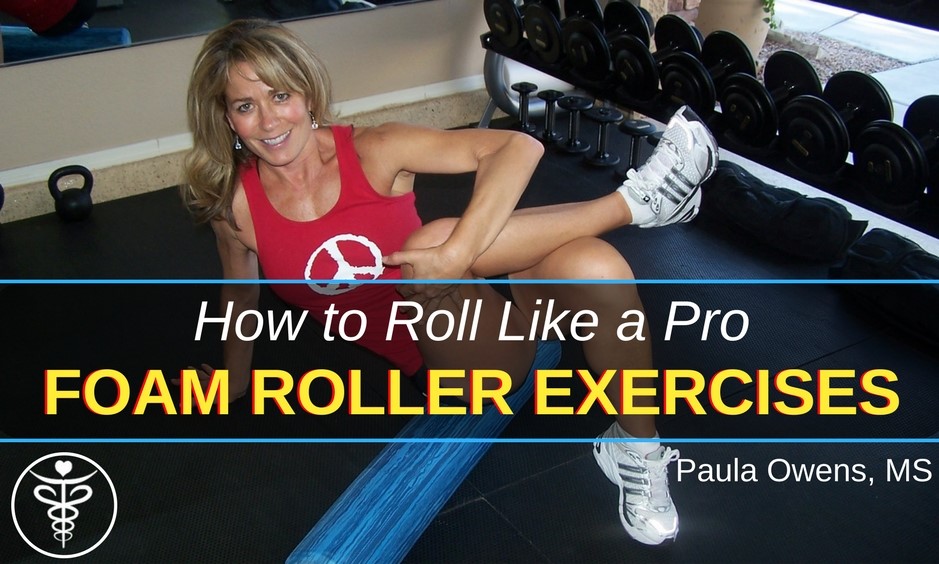
Do you experience restricted movement? Aches and pains? Sore, tight muscles? Poor posture? Text neck? Sit too much? Any of these can result in poor performance, fatigue, altered breathing patterns, degenerative disc disease, neck, knee and back pain, headaches, structural imbalances, and other health problems. Bring your body into balance by using the foam roller for just a few minutes every day.
The Benefits of Foam Roller Exercises
Foam rolling is a very therapeutic technique that helps to break up muscular knots, tight fascia and connective tissue tension.
? Improved muscle recovery, alleviates delayed onset muscle soreness (DOMS)
? Self-myofascial release (SMR) using the foam roller can assist in breaking down scar tissue and encourages the release of fascia as you work your way from one end of the muscle to the other (starting at the origin and working toward the insertion).
? Foam roller exercises are highly beneficial and effective injury prevention, prehab, rehab and recovery self-care therapy that is easy, effective and inexpensive
? Promotes and supports a healthy lymphatic system
? Foam rolling helps to release trigger points and knots, and minimizes pain, tension, muscle tenderness and joint pain
? Improves posture
Round foam rollers come in various lengths and densities that can be used to release trigger points and break up tight and tangled fascia. I use a foam roller that is 6″ round and 36″ long.
How to Use the Foam Roller
Learning how to effectively use a foam roller pre- and post-exercise training or for DIY physical therapy can be a major game changer for your posture, workouts, performance and recovery. Exercise can induce various degrees of fatigue in the musculoskeletal, nervous, and metabolic systems. Various degrees of discomfort or pain and inflammation can be associated with a sedentary lifestyle and also with exercise, depending on the frequency, intensity, duration, and type of exercise performed.
During self-myofascial release (SMR), pressure is applied to a muscle using a foam roller causing activation of the Golgi Tendon Organ (GTO), which in turn signals muscle spindles to release and relax the muscle being worked on. The GTO is extremely sensitive to changes of tension in the muscle.
-
Locate an area that has a reduced range of motion, a tight muscle or trigger point or an area that is overused
-
Stop on tender spots for 20-30 seconds and breathe deeply. Continue to breathe slowly and deeply as the discomfort subsides by 50-75%. This could take some time and may be uncomfortable. The point is to relax as the area softens and releases
-
When the area is no longer sensitive, begin to roll to other tender spots on the muscle you’re focusing on and repeat.
Foam roller exercises post-training (after exercise) can be held for longer periods of time to enhance recovery from DOMS while breathing deeply. Trigger point therapy using the foam roller before exercise prepares and excites the body for the imposed demands and activity that will be placed upon it.
Trigger Point Therapy for Your Feet
Foam Roller Exercises
Glutes and Piriformis
To target the piriformis, bring the ankle of the working leg above the knee of the supporting leg. Position your body so the side of your glute (the meaty area), above the hip bone, is on the foam roller. Adjust the pressure as you shift your weight forward and back on the roller to locate the trigger point within the external hip rotators. Helps with relieving low back pain (LBP).

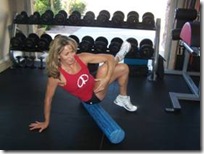

Quadriceps
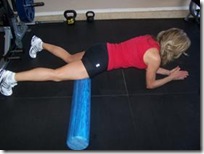 Start with the foam roller at the middle of your thigh. Work the top half of the quad first, starting at the mid-thigh working toward the top. Then, work all the way down the front of the thigh to your knee. Position yourself so the front of your thigh is resting on top of the foam roller. Be sure to work both the vastus medialis (inner area of front thigh) and vastus lateralis (outer area of front thigh) by adjusting the angle of your thigh on the roller.
Start with the foam roller at the middle of your thigh. Work the top half of the quad first, starting at the mid-thigh working toward the top. Then, work all the way down the front of the thigh to your knee. Position yourself so the front of your thigh is resting on top of the foam roller. Be sure to work both the vastus medialis (inner area of front thigh) and vastus lateralis (outer area of front thigh) by adjusting the angle of your thigh on the roller.
Illiotibial Band (ITB)

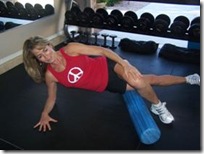 Position yourself to the side so your outer thigh is resting on top of the roller. Place the foot of the opposite leg on the ground in front of you. Make sure you do not turn too far on to the front or back of the thigh. Start in the middle of the ITB and work toward the top of the muscle. Continue to work all the way down the outer thigh ending above your knee.
Position yourself to the side so your outer thigh is resting on top of the roller. Place the foot of the opposite leg on the ground in front of you. Make sure you do not turn too far on to the front or back of the thigh. Start in the middle of the ITB and work toward the top of the muscle. Continue to work all the way down the outer thigh ending above your knee.Glute Medius

Upper Back, Rhomboids and Trapezius
Lie with your shoulder blades on the foam roller and your feet on the ground. Your butt is off the floor and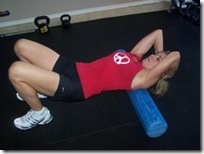 your hands cradle the weight
your hands cradle the weight 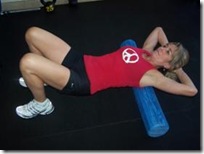 of your head, supporting your neck. Draw the elbows toward one another to focus more on the rhomboids.
of your head, supporting your neck. Draw the elbows toward one another to focus more on the rhomboids.
Latissimus Dorsi (Lats)

Lie on your side and place your armpit on the foam roller. The arm is straight, thumb up. Rotate the arm externally until you feel a stretch in the lat and then return it to the starting position. This particular foam roller exercise flushes toxins toward the concentration of lymph nodes in the arm pit.
Thoracic Extension

Spinal Mobilization

Lie vertically on the foam roller with your head and your entire spine down to the sacrum supported on the foam roller. This helps restore the natural curves of your spine and elongates the anterior longitudinal ligament of the spine.
Stay here, chill, relax and breathe deeply for 2-5 minutes.
Related Articles
- Mindful Breathing Exercises
- Natural Remedies to Heal Injuries Faster
- Tips to Support a Strong, Healthy Lymphatic System
- Video: Are You Low in this Mineral?

